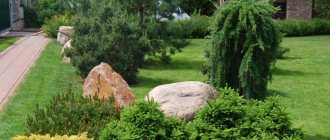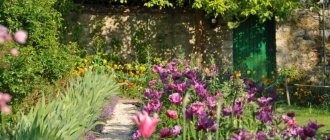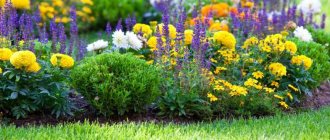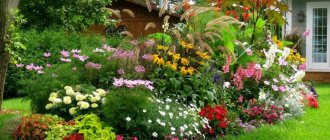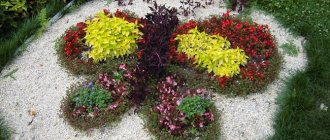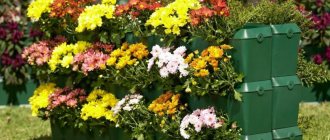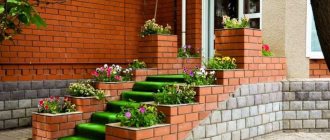Owners of country houses and summer cottages have long ceased to prioritize the cultivation of agricultural crops. Many modern areas are decorated with all kinds of ornamental plants. Almost all landscape projects include perennial beds. An ideal flower garden continues to delight those around you with the beauty of its leaves and buds throughout the season. Continuous flowering can be achieved by strictly observing planting rules, soil requirements for each plant, and the correct selection of varieties.
Peculiarities
A bright, dense flower bed will only be possible in a lighted area. To correctly create a composition, you need to select plants in advance and imagine the appearance of each specimen at different times of the year. Transforming a garden is a labor-intensive process that requires constant presence in the garden beds. Before you start working with soil, you should consider the following nuances:
- Soil features. Each flower has its own type of soil;
- Climate. Emphasis should be placed on pure varieties and hybrids that take root well in the planting region;
- Terrain. You can make a beautiful flower bed on a flat surface, on a slope, or in a lowland. A certain type of plant is suitable for each option;
- Illumination. Not all colors are suitable for a sunny area. Species that love partial shade are best planted in a flowerbed near the fence, next to tall bushes;
- Planting density. It is necessary to maintain a certain distance for each plant in the circle of neighboring flowers;
- Flowering dates. In order for the flowerbed to delight with color throughout the summer season, varieties should be selected with different flowering periods and durations.
Types of flower beds
The size of the flower bed can be very diverse. The choice depends on the area of the site and the availability of free space. Flowerbeds with perennials are classified as follows:
- Modular. The plants in the flower garden are separated by tiles and various architectural products;
- Mixborders. Place under windows, along paths. The compositions consist of a variety of colors;
- Solitaires. Flower beds contain plants that are similar in some way (color, shape of petals, size, height of stems);
- Discounts. Elongated planting of monochromatic plants. Often they represent a certain ornament and are part of a large flower bed;
- Curbs. Short strips of low plants. They are used to highlight certain areas of the flower garden;
- Rockeries. The plants in the flowerbed are complemented by decor made of stones; the popular name is stone gardens;
- Rock gardens. Flowers grow on a hill in several tiers.
Carpet plants
The color of carpet plants is often not considered in the design. Instead, use an ordinary lawn. This is a common mistake. You can plant plants that cover the ground and protect against weeds. Moreover, many of them feel great in shady corners.
- periwinkle;
- tenacious;
- budra;
- Zelenchuk;
- Brunner;
- Tiarella.
Such species cover the ground with a dense cap, comparable to a “carpet”. It hides the soil and prevents weeds. At the same time, they have the advantage of long flowering. The lush greenery begins to bud early and fades only in late autumn.
Flowerbed shape and size
The size of the flower bed, as well as its decorative contents, is chosen based on personal preferences. In order not to spoil the overall appearance of the site and not to destroy living plants, some design factors should be taken into account. It is necessary to provide for free space on the estate, the number, and location of buildings.
They also pay attention to the location of the house. If it is located in the center of the yard, all its windows overlook personal territory, it would be logical to make a beautiful flowering flowerbed of any fancy shape in front of them. Paths and driveways are decorated with narrow flower beds of small, climbing plants.
Flower beds of regular geometric shape look better on a flat, well-groomed lawn. You can emphasize the boundaries of round, square, rectangular flower beds with the help of fences and low fences. Arched, abstract planting is carried out in the form of combinations of several varieties and groups of plants. For example, large spherical bushes surrounded by several rings of bright flowers.
Before selecting plants, even for the simplest flower garden, it is necessary to develop a detailed diagram.
Shade-loving deciduous trees
A beautiful corner design on a site can be quickly created with the help of deciduous plants. The needles grow for 5-6 years to a suitable height. Because of this, designers point to a good selection of shade-loving deciduous species:
- fern;
- host;
- Heuchera.
The only negative is the low height. They won't grow to be a large spruce, but that won't ruin the project. Experts advise planting them on a hill. The result will be openwork slides, which, together with bright colors, will diversify the landscape. This method also involves creating a small reservoir for constant humidity.
Flowerbed design
You won’t surprise anyone with simple flower beds. Plants are planted not only in open ground, but also in various objects raised above the ground. They are often made in the same style as a terrace, veranda, swimming pool, or the nearest building. In just a couple of hours, any item that has been collecting dust in the barn can turn into an original landscape design object. The following types of flower beds can decorate your garden:
- Regular. Plants are arranged symmetrically, tightly, in even blocks. Flowers must have one flowering period and height. Hybrids are more suitable for this purpose;
- Irregular. A free-form flower garden with perennials that bloom alternately throughout the season;
- Carpet. The close arrangement of low-growing plants creates a carpet effect. Various inert materials (pebbles, sand) will help create a clear pattern. The most popular design example is the flower clock;
- Elated. A non-standard flower garden is raised above the ground by 20-100 cm. It can be in one or several tiers. A combination of ground cover and tall plants is possible;
- Vertical. Used to save space. Place it on the ground, hang it, attach it to any surface. The main advantage of this design is that there is no need for weeding;
- Multidimensional. The unusual flower garden is located not on a plane, but in volume. To create compositions, auxiliary structures are used. For example, a flowerbed made from an inverted umbrella, on a chair, in a cart;
- Ring. They are located in a ring around an object (tree, bush, large stone). To prolong the bright color, plants alternate according to the flowering period;
- Ostrovnaya. Includes plants of varying heights. The tallest perennials are in the center, low-growing along the edges;
- Flowerbed-panel. A complex flower garden resembles a carpet bed and reflects a specific image or inscription;
- Modular. In one space, flower beds unite individual areas with one concept. They are separated by slabs and paved paths.
How to properly plant a flowerbed yourself
Prepare the site. Its level should be higher than the sidewalk level. Achieve elevation by making a mound of the desired size.
Give the site the required shape. A cord will help you make a circle, and a regular tape measure will help you make a square or rectangle.
If desired, you can build a fence from bricks or irregularly shaped stones.
Plant the plants selected in advance. First, plant those of them that are assigned the role of central figures (no more than 3 - 5 pieces). These can be perennials, evergreens, bushes and even small trees. Then plant the rest around them. Remember, low plants are usually planted along the edges of the flower bed.
Basic rules and recommendations for creating flower beds
When organizing a flower garden with your own hands, you should adhere to certain rules so as not to end up with a chaotic planting. Creating flower arrangements is a real art. You can avoid common mistakes if you listen to the recommendations of landscape designers.
Choosing a planting site and soil
The choice of location is influenced by the size and shape of the flower bed. It should be clearly visible and not interfere with passage, passage, or walking of animals. The best place is the front part of the garden, the entrance to the courtyard. Flower beds near the terrace and pool look great. In a well-lit area, even the most primitive plantings will look impressive.
All plants in a flower garden should have the same soil requirements. Fertile soil will be successful for all specimens. It must be fed with mineral and organic fertilizers. Perennials do not require replanting and careful care compared to annuals.
Plants that are well adapted to the region of planting will quickly take root.
Drawing up a plan and color scheme of plants
Planning a flower bed begins with drawing a diagram. First of all, we decide on the design. On paper, you need to indicate the planting zones, the expected number of plants, and their type. If necessary, the location, design features and size of decorative elements should be taken into account.
You can combine a variety of colors in a flowerbed. It is better not to make it too contrasting, with sharp transitions. Monochrome flower beds look beautiful - pink in summer, yellow in autumn. Combinations of two adjacent shades look advantageous - blue and purple, red and orange. Multi-colored mixborders are planted according to special patterns, with a choice of dominant and complementary tones.
Correct height distribution
When creating a composition, the height of the stems and bushiness are of great importance. The longest perennials are placed in the center or in the background if they will not create a shadow for the rest of the plantings. For edging, low-growing flowers (up to 20 cm) are used. There is room in the middle for those of average height.
The center can also be occupied by dwarf trees and low-growing coniferous shrubs. Their height should not exceed a third of the diameter of the flower bed. For flowers of the same height, a flowerbed in the shape of a flat pyramid is suitable. Bulbous plants that bloom early are best planted in the center so that their fading flowers are hidden behind the greenery of perennials.
Seasonality/flowering time
Plants for a flower bed are chosen depending on the expected effect. For simple flower beds, it is better if they are varieties with the same flowering period. In this case, the carefully thought-out pattern will not be disrupted. For constant color the range of species must be very large. The integrity of the composition can be achieved by planting flowers in groups, regardless of the size of the buds.
In a small flowerbed, it is better to place plants that smoothly change colors and decorate the area in a certain season. When grouping, you should take into account the growth rate and the size of each finished specimen. Species that grow too quickly will have to be contained.
Tips for designing and choosing plants
To plan a beautiful corner flower garden, you need to know the order of combining plants according to color, growth, and flowering period. The requirements of crops for care and growing conditions are taken into account. A few tips from experienced gardeners will help decorate your garden plot:
- Heads of any colors follow the movement of the sun. However, some do this intensively, while others not so much. If the corner place for the flower bed is located with the front part facing north, it is better to choose the second option from the flowers. Marigolds, irises, and delphinium are suitable.
- When a flower bed is located in the corner of a picket fence, it is visible into the yard and onto the street. Here we need a choice. Flowers are selected so that they delight the owners or passers-by.
- If the bed is sown with seeds instead of seedlings, a good gap is left between groups of plants. In June the flower garden will still be empty, but by mid-July it will be overgrown. Dense plantings will have to be broken through and aggressive crops fought.
- During planning and drawing up the diagram, the height of each flower is taken into account. Data can be found on the seed packaging. If some plants are densely planted, you can try to replant them.
- Flowers left for seeds are marked in advance by tying a ribbon or any tag. This must be done during flowering, otherwise it will be difficult to find them later.
- Caring for plantings involves the procedure of removing faded inflorescences. In addition to preserving the decorative appearance of the flower bed, the flowering period of crops increases.
- It is undesirable to create large groups from one variety. When the flowers fade, an unsightly spot of dry stems forms in their place.
- There are flowers that bloom only at night, in the afternoon or in clear weather. This property is important to consider when drawing up a diagram.
The tips will help you create a general idea of the design. The owner will have to decide most of the remaining nuances on his own.
In the video, a selection of shade-tolerant plants:
Popular perennials for flower beds
Every experienced gardener has a list of their favorite plants. Generally, preference is given to highly decorative flowers that do not require special care. The following types are an effective decoration for a summer cottage in the summer and spring seasons:
- Astilbe. A shade-tolerant plant with feathery, toothed leaves. Sometimes simple forms are found. Flowers form fluffy panicles of different colors and sizes.
- Helenium. Tall perennial with bright orange buds. Blooms profusely and for a long time, from mid-summer to the first frost;
- Geranium is magnificent. Grows as a spherical bush in partial shade. The leaves remain attractive green all season, turning purple in the fall. Blooms in late spring;
- Catnip. The herbaceous plant does not require special conditions and forms lush bushes up to 1 meter high. All its parts have a pleasant aroma. Blooms profusely and for a long time in the sun.
- Oriental poppy. With its beauty it can outshine almost all its neighbors in the flowerbed. Large red, pink, flesh-colored buds on meter-long stems bloom in early summer.
- Cuff. Decorates the garden from early spring until late autumn. It is famous for its unusual leaf shape and ability to guttation. Some species stand out for their abundant flowering, others for the color of their foliage and stem.
- Sedum. The perennial is varied in texture and color. Fits perfectly into any plant composition. Inflorescences up to 15 cm in diameter, stems up to 80 cm high;
- Rudbeckia. Long stems with yellow flowers can be seen from afar. Blooms in summer and autumn. Inflorescences can be one-color or two-color;
- Yarrow. Low-growing varieties are planted in a rocky garden, species with a long stem in the background of mixborders. Inflorescences in the form of baskets of different shades decorate flower beds from June to October;
- Hosta. The problem-free plant gets along well in the flower garden with all its neighbors. Does not like sun and strong wind. Large leaves have decorative value;
- Sage. The fragrant, diverse perennial has many species. It mainly blooms purple, but there are yellow and red inflorescences;
- Japanese anemone. Most varieties of this beautiful plant bloom in the spring, some twice a season. There may be solitary buds or collected in inflorescences.
Corner sunny flower bed of annuals
Ticket number 4.
Beauty for one season. A flower garden dominated by annual plants. In front of the house I have a plot measuring 10x12 m, almost flat (a slight slope in the very corner near the fence). The previous owners planted this area with lawn grass. I want to plant flower beds here, make paths, and if possible, even place a small pond. The wrought iron fence will be covered with a 2 m high metal profile to protect it from cars rushing along the dirt road.
In front of the house
I drew the diagrams by hand and finalized them in Photoshop. I tried to show this area in front of the house on the diagram.
General form
Since the area needs to be improved is quite large, it is easier for me to start doing this based on a specific landmark. So I decided to start from the corner.
In the very corner from the east sits a young thuja 1.5 m high and 40-50 cm in diameter at the base and very thin at the top. About 4 m from the corner there grows a shrubby willow 1.5-2 m high. In summer there is no long shadow from it, and the flowerbed will be constantly in the sun.
So, the flowerbed is located in the front garden in the sun. It will have the shape of a scalene triangle. On the south-eastern side 2.5-3 m, on the north-eastern side about 3.5-4 m (it will be clear when I start planting seedlings on site). Humidity is moderate. The soil in this place is loam, significantly mixed with sand.
The flowerbed will be visible from one side from the entrance area in front of the house. The landscape composition will be decorative from June until frost. If the flowerbed had been planted in the fall, then in the spring tulips would bloom on it, since these are my favorite flowers, and I try to plant them everywhere.
I selected the plants for the flowerbed that I had in stock. Four seedlings are already growing, cleome and gillyflower have been sown, and I’m waiting for their shoots.
Contrasting colors were chosen in the color design, the purpose of which is to distract from the gray nondescript fence. 4 out of 6 plants are mixtures of colors. I tried to choose options that would be combined with each other. I will plant blue lobelia in the legs for shading. There is a green lawn around.
I tried to create a collage using images from seed packets.
All plants require standard care - watering as needed, timely fertilizing, picking off faded inflorescences. Disease prevention.
Between the fences and the flowerbed along the perimeter there will be a strip of lawn 0.5 m wide, sufficient to be walked on and mowed with a trimmer. There will be no fences or borders. I plan to separate the flowerbed from the lawn with a narrow, about 20 cm, strip of clean earth sprinkled with light sand.
Flower garden diagram
The crosses in the diagram show the number of plants that will be planted. Based on the scale in the diagram, I immediately tried to calculate the required number of roots. Lobelia will be planted in clumps. At first I was going to place annual asters in the second row under No. 4 for a nuance with chrysanthemums. But when I reviewed all the sown bags, it turned out that their height was stated to be 60-70 cm, and they would block the snapdragon. Having sorted through dozens of bags of flowers, two of them turned out to be the right size - low-growing dahlias and gillyflower. Dahlias don’t fit into this flowerbed at all for me, but I think the leftover will look harmonious, gradually turning into a snapdragon.
All flowers are annual.
Plant assortment list
It should be noted that the lawn will delight not only with its beauty, but also with its enchanting aromas, which I really love.
In the future, when we make a pond, it will be possible to build an alpine slide in this corner.
Recommended planting patterns
Beginner gardeners are better off practicing in a small area with good lighting. It is important not only to choose the right varieties, but also to correctly distribute the plants in the flower garden. In this case, it is necessary to take into account the size of the buds, inflorescences, the shape of the petals and leaves, the height of the stems and bushiness. In order for the composition to look as natural as possible, it is necessary to strictly follow the layout when planting according to the chosen scheme.
Simple planting scheme
To create the composition, unpretentious, hardy perennials are used. The flowerbed can be round, square, triangular. The following plants are used:
- The first planted in the center is paniculate phlox, purple and pink. You can do this in the fall or spring. Blooms all summer and September.
- Pink astilbe is planted in front of it. It begins to bloom a little earlier than phlox and ends in August;
- The daylily is placed on the same line with the astilbe. Planting is carried out in spring in well-drained soil.
- Heuchera is used for edging. Its silvery leaves will highlight a flower garden at any time of the year. Blooms in May, earlier than all collected species;
- You can make accents with the help of magnificent geranium bushes. Light flowers appear in mid-summer and remain until the end of the season.
Flowerbed of plants blooming in the first year
- The tallest hollyhock roses are planted in the background. You can use one variety or plant single plants of several colors. They will bloom in mid-summer;
- At the same level, the place is prepared for sunflowers. It grows quickly, so you should provide more space for it. Blooms in August until cold weather;
- Spanish poppy will be an excellent addition to a long-flowering flower bed. The first buds appear in May;
- St. John's wort is placed on the midline. It will catch the blooms of early species in June;
- For lobelia cardinalis, make room in the center. Thanks to the original leaves and bright flowering, it always remains attractive;
- The first lavender catnip flowers appear in May;
- The lower level is planted with bells. Already in June they will create a dense blue carpet;
- The beautiful blue baskets of Catananche “Blue Cupid” can be admired all summer long;
- The blue color of the lower part of the flowerbed dilutes the perennial gravel;
- The largest inflorescences of the sedum “Matrona” linger in the flowerbed the longest;
- Unusual leaves and flowers of Heuchera "Miracle" - a spectacular decor for a flower garden in the middle of summer.
Flowerbed in shades of pink and red
- Variable knotweed is placed in the center. White flowers appear on a large shrub in midsummer;
- Monarda hybrid attracts not only its stunning pink color, but also exudes a refined aroma;
- The purple leaves and red small flowers of astrantia look great as an edging;
- The opposite side of the flower bed is decorated with Saxifraga pachyfolia. The first inflorescences appear in May;
- The bright composition is successfully complemented by the “Dragon” phlox. A place is allocated for him in the center;
- Heuchera, with deep red leaves, bursts with color in June;
- The lush geranium “Compactum” adds bright red tones to the flower garden;
- The riot of colors is diluted by the soft pink flowers of the sedum “Matrona”;
- Loddon Anna bells fill the garden with a subtle aroma.
Recommendations
Landscape decorators give the following recommendations for creating a flowerbed with your own hands:
- You should not choose flowers for your flower bed thoughtlessly. They must be combined with each other.
- The most popular are flower beds with regular geometric shapes, since they are easier to fit into the existing landscape.
- When designing this type of flower garden, you need to take into account the configuration of architectural structures in the local area.
- The flowerbed should only be placed in an area where there is a suitable background for it.
- To create a flower bed, it is best to opt for low-maintenance flowers.
- Before you get down to business, you need to think through a clear procedure. This will help avoid mistakes.
Creating a continuously blooming flower bed
The main advantage of such a flower bed is durability. It will decorate the area with bright color all season long. You will have to spend money on purchasing seeds once. Such plants do not require additional care or frequent feeding, since they do not deplete the soil. You can choose any place for planting, but in a sunny zone, development and flowering will be more intense.
To achieve maximum picturesque effect, it is not at all necessary to plant many different varieties. For a continuous flowering flower garden, 5 types of perennials will be enough. The first group blooms in early spring. These can be crocuses, tulips, daisies, peonies. In summer they are replaced by roses, hibiscus, lilies, echinacea, and hydrangea.
Calm, noble color envelops the flowerbed with the arrival of autumn. During this period, phloxes, cannas, and carnations open their buds. Until the very frosts, coniferous evergreen perennials, tree-like ornamental plants, and golden spheres of craspedia will delight the eye.
How to care for flower beds
Any garden cannot be left without attention. To obtain regular results, even the most unpretentious plants will require constant care. Throughout the summer season, you must perform the following actions:
- Watering. It should be plentiful and regular, especially on dry days, during the growing season and flowering. The readiness of the soil for flower beds with a wide variety of species is checked by touch. If the top layer of 10 centimeters is dry, it must be moistened.
- Weeding, loosening. Particularly important in a large flower bed. The root system of all garden specimens must breathe without experiencing nutritional deficiency. It is necessary to work manually so as not to damage the roots of the plants.
- Fertilizer. You can maintain soil depleted over the years with mineral and organic fertilizers. Feeding takes place three times a year. The first is in early spring, then when buds appear and in mid-autumn.
- Trimming, garter. Special supports will help some perennials to be decorative. Tall species will keep their shape and will not fall apart under the weight of their large flowers.
- Preparing for winter. The procedures are carried out in late autumn. Cut off all dried parts and cover the flowerbed with mulch. Heat-loving species are dug up and transferred to a container.
Beautiful ideas for creating a flower garden
The beauty of a flower bed depends on the correctly selected varieties, arranged in a certain pattern. But we must not forget about arranging the flower garden itself. A good solution would be to designate clear boundaries. You can use any available materials.
You can make an original flowerbed in the center of the site from wood. This could be a low fence made of boards or stumps, or hanging structures. To create flower beds of various heights, you can use stones and bricks. An “alpine slide” will fit perfectly into the landscape design.
The garden will be decorated with original flower beds made from old tires, furniture, and plastic bottles. You can use a rusting car that cannot be repaired, a metal mesh, or an old piano.



